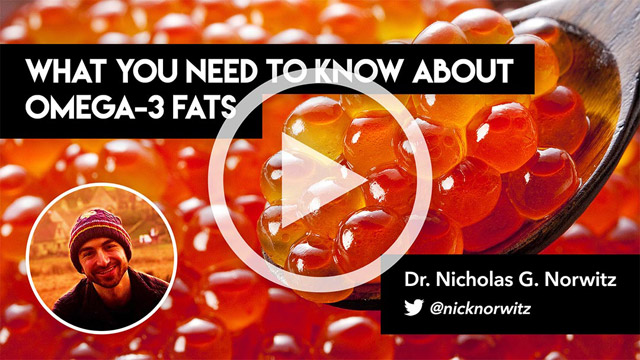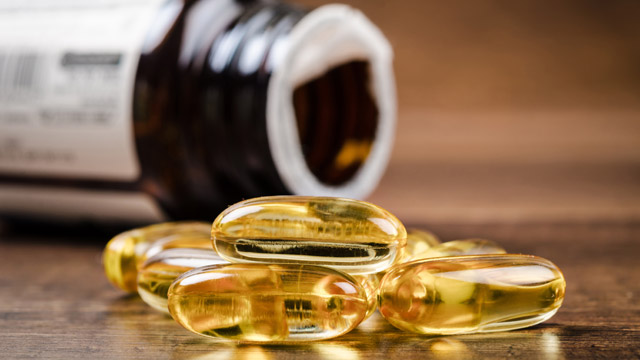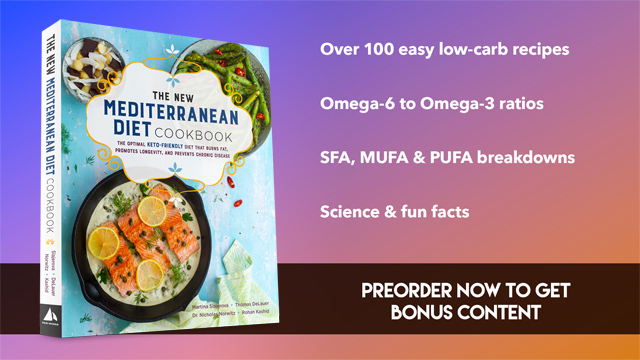Follow us 261.1k
Quick Summary tl;dr
Here is your Omega-3 hierarchy: (1) Lyso-DHA from kill oil or fish eggs (roe), (2) EPA/DHA from sockeye salmon and other SMASH fish (3) ALA from plants.
Lyso-DHA gets privileged access to the brain, making it the best of the best Omega-3. Lyso-DHA is concentrated in krill oil and fish eggs (roe).
Sockeye salmon are an awesome source of DHA because they contain DHA's cellular body guard, astaxanthin.
Salmon, mackerel, anchovies, sardines and herring (SMASH fish) are great for EPA/DHA!
To get the most out of Omega-3 from plants, like flax and chia, add turmeric & black pepper to boost conversion of ALA into EPA/DHA.
Everyone can agree that Omega-3 fatty acids are good for you, period! They are good for your brain, heart, gut, muscles, and basically everything else. But, as is always the story with nutrition science, the topic is a bit more nuanced. Here, we are going to unpack the wonderful world of Omega-3s.
To watch our 6 minute video, click here.

Understanding Three Types of Omega-3 Fatty Acids: ALA, EPA & DHA
The first thing to know is that there are three types of Omega-3 fatty acids. They are:
- short-chain alpha-linolenic acid (ALA)
- long-chain eicosapentaenoic acid (EPA)
- long-chain docosahexaenoic acid (DHA)
Sources of ALA include certain nuts and seeds, in particular flaxseeds and chia seeds. EPA and DHA are derived mostly from fatty seafood.
Eat SMASH Fish: Salmon, Mackerel, Anchovies, Sardines, Herring
Here’s a helpful acronym to help you remember the most common sources: SMASH!
SMASH fish include salmon, mackerel, anchovies, sardines, and herring. (For practical reasons, salmon, mackerel and sardines are probably your best options. That’s because anchovies and herring are often canned with excess sodium or sugar, respectively. But if you buy them wild and fresh, that's not a problem.)
Free Download
Trialed & tested for best results
Optimized for nutrition
Never feel hungry
Track all macros including net carbs
Scan products
Create your own meals
Track ketones, blood glucose & lipids
Stay hydrated with water tracking
Track your mood & energy levels
Calculate your ideal fat, protein & carb intake
Set any goal: weight loss, maintenance or weight gain
Your macros update based on your progress
Monitor your macros, water intake, mood & energy
Body weight, body fat and body measurements
Ketones, blood glucose & lipids
Expert articles to help you make informed choices
Guides & free diet plans
New daily content
Complete Keto Diet guide
Integrated shopping basket
Restaurants & guide to eating out
Free Download
Choose Fatty Seafood Over Nuts and Seeds
If you remember nothing else from this update, remember this: EPA and DHA are better than ALA!
Therefore, you should aim to consume seafood for Omega-3s, rather than solely rely on nuts and seeds. Now, that’s not to say nuts and seeds, like flaxseeds and chia seeds, are bad or useless. In fact, ALA can be converted in the body into EPA and DHA. Unfortunately, this conversion only occurs at extremely low levels. Estimates vary, but the conversion rate of ALA to EPA/DHA is generally thought to be 5% or less.( 1)

Are You Vegetarian? Add Turmeric & Black Pepper, or Algae Oil
Are vegetarians doomed to a life devoid of EPA and DHA? Well, not exactly. We have two recommendations for vegetarians. The first involves one of our favorite spices, turmeric!
An experiment in rats showed that supplementing rats with ALA and turmeric increased the expression of proteins that transform ALA into EPA and DHA. It also showed that the ALA plus turmeric combination actually increased levels of DHA in the rats’ brains! ( 2) Granted, this is a rodent study, and animal data don't always translate into humans. But given that certain studies, like this one, require lopping off heads at the end of the intervention, I think we can give that a pass. Something tells us it would be hard to recruit people for such a study. Agreed?
Therefore, vegetarians might consider consuming turmeric (or curcumin supplements) when they eat plant sources of Omega-3s. Adding some black pepper increases curcumin absorption and enhances the process. Another option for vegetarians is to take algae oil supplements. Algae oil contains EPA and DHA just like fish. In fact, fish get EPA and DHA mostly from eating algae.
To get the most out of Omega-3 from plants, like flax and chia, add turmeric & black pepper to boost conversion of ALA into EPA/DHA.
Best of the Best Omega-3 Fats For Your Brain
So, EPA and DHA are better than ALA. Is that it? As it turns out, the power of DHA — which is the canonical brain super fat — can be further enhanced if it’s attached to a lipid called phosphatidylcholine. This form of DHA is called “lyso-DHA.” Lyso-DHA is the best of the best Omega-3. That’s because it is more bioavailable and gets privileged transport into the brain via a transporter called MSFD2A. ( 3)
One epidemiological study followed 899 elderly people from the famous Framingham-offspring cohort for an average of 9.1 years. They observed that subjects who had higher blood lyso-DHA levels had a 47% reduction in risk of developing all-cause dementia. (All-cause dementia includes Alzheimer’s disease.) These subjects had an average fish intake of 3 servings per week. ( 4)
A study in piglets built on this correlation. They found that providing the baby squeakers with lyso-DHA formula caused incorporation of DHA into their growing brains that was twice as efficient as normal DHA! ( 5) Even better news came from a double blinded, randomized placebo-controlled, crossover trial in humans. (That’s jargon for, “a really good type of study.”) This study found that a lyso-DHA supplement, in the form of krill oil, was better at improving Omega-3 levels than just a regular EPA/DHA fish oil supplement. ( 6)
Best Lyso-DHA Sources are Roe and Krill Oil
The best sources of lyso-DHA are salmon caviar, as well as fish eggs (roe) from other species, and krill oil. For reference, most EPA/DHA supplements contain no lyso-DHA. SMASH fish contain about 1.5% lyso-DHA. Finally, fish roe and krill oil each contain upwards of 35% lyso-DHA! Huh. Maybe that barracuda from Finding Nemo wasn’t evil but just nutritionally informed.
The best of the best Omega-3 is Lyso-DHA, which has privileged access to the brain. Krill oil and fish eggs (roe/caviar) are rich in Lyso-DHA.
Sockeye Salmon: The Redder the Better
The end? In science, never! Omega-3s don’t exist in food alone, and it’s important to consider the broader whole food when choosing your Omega-3 sources.
For example, we love sockeye salmon in particular as a source of EPA and DHA. Not only is it a great source of Omega-3s, but it comes packaged with a cellular bodyguard for our healthy fat friends called “astaxanthin.” Astaxanthin is the antioxidant that gives sockeye salmon their lovely red-pink color.
Why is astaxanthin so important? Omega-3 fats are fragile and prone to damage by the process of “oxidative stress” which is when free radicals damage other biomolecules. But astaxanthin protects EPA and DHA from oxidative stress! In fact, salmon evolved to increase their expression of astaxanthin during their upstream journey to spawn. This specifically protects their own EPA and DHA from the oxidative stress that occurs during this marathon trek. When it comes to selecting your sockeye salmon, remember, “the redder the better!”
When it comes to salmon, the redder the better. Redder salmon have more astaxanthin, which protects Omega-3 fats. Alaskan sockeye is the best.
Omega-3 Summary: What to Remember
In summary of the Omega-3 hierarchy:
- Lyso-DHA is the best, and EPA and DHA are better than ALA.
- Aim for salmon caviar and krill oil for lyso-DHA, and SMASH fish (salmon, mackerel, anchovies, sardines, and herring) for EPA and DHA.
- If you’re a vegetarian, consider having flaxseeds and chia seeds with turmeric and black pepper, or consider getting an algae oil supplement.

Considering Omega-6 Fatty Acids
Mind Your Omega-6/3 Ratio
But just as important as considering astaxanthin is considering Omega-3’s mischievous sibling, Omega-6s. Don’t get us wrong, your body does need some Omega-6s to function, but most of us consume far too much.
An ideal Omega-6/3 ratio is 3:1 or below, but most Americans have a ratio of 12:1 or above. This high ratio can increase inflammation, which is another harmful cellular process that goes hand-in-hand with oxidative stress. Inflammation is associated with chronic diseases ranging from obesity to cardiovascular disease, diabetes, metabolic syndrome, and Alzheimer’s disease. Therefore, it’s important to be mindful of not only your Omega-3 intake, but your overall Omega-3 and 6 balance.
Let us provide an example. Let’s say you have a yummy 6-ounce fillet of sockeye salmon, containing about 1.9 grams of Omega-3s, but you cooked it in 2 Tbsp of grapeseed oil. Unfortunately, that amount of grapeseed oil contains about 19 grams of Omega-6s, putting your Omega-6/3 ratio at an alarming 10:1! Yikes
Cooking Oils: What to Embrace and What to Avoid
In terms of lower Omega-6 cooking oils and fats, we recommend macadamia nut oil, ghee, virgin coconut oil, or beef tallow. Avocado oil and butter are a pretty good option too!
Oils we recommend avoiding include grapeseed oil, soybean oil, corn oil, and really any nut or seed oil that is not macadamia or avocado.
To reduce your Omega-6 intake, and improve inflammation, use ghee, virgin coconut oil, or macamia nut oil when cooking. Don't use vegetable oils.
Omega 3 and Omega 6 Fats in Nuts
Certain nuts, like walnuts, are perceived to be great sources of Omega-3s, but there are two catches. First, all those Omega-3s are ALA. Second, walnuts contain about 4.5 times as much Omega-6 fat as Omega-3 fat. Therefore, their overall Omega-6/3 ratio isn’t ideal and the Omega-3s that are present are only ALA.
If you want to get mathy and apply the 5% ALA to EPA/DHA conversion rate, then that reasonable 4.5:1 ratio jumps to a ghastly 90:1 ratio. Perhaps consider swapping in some lower Omega-6 nuts, specifically macadamia and hazelnuts.
Walnuts are not a good source of Omega-3. They don't contain EPA/DHA and they have far more Omega-6 fats. And never heat a walnut above 130 °C/ 270 °F.

Should I Take Omega-3 Supplements?
We are often asked if it’s okay to supplement Omega-3s, rather than consume them in whole foods. In general, whole foods are a preferable source of Omega-3 fatty acids for three reasons:
- Omega-3s in whole foods come the way that nature intended, cleverly packaged with molecules that support their function, like astaxanthin. This actually goes for Omega-6s too.
- Omega-3s in whole foods are often themselves in more bioavailable forms, like lyso-DHA.
- Finally, and perhaps most importantly, Omega-3 supplements often contain oxidized Omega-3s. It’s really hard to know if your supplement contains fresh or damaged Omega-3s.
Vegetarians can do with algae oil, as there aren’t many better options, and those wanting extra can supplement, but it’s always best to eat whole foods as your primary source of Omega-3s.
How to Include More Omega-3 Fats in Your Diet
So, let’s do like a sushi chef and wrap-up, but with practical advice rather than sticky rice.
1. Eat Wild Caught Fish
Try to eat wild-caught fatty fish at least twice per week. Certain people might benefit from more fatty fish. These include those carrying a gene variant called ApoE4. ( 7)
2. Fresh and Frozen Fish is Better than Canned
When buying seafood, opt for wild caught fresh or frozen, when possible. Fish in jars or cans often have added sodium, sugar, or the Omega-3s have become damaged.
3. Make Smart Seafood Choices to Minimize Mercury Intake
Also, try not to eat high-mercury fish too often, including tuna, swordfish, and king mackerel. Fish that are lower on the food chain have lower levels of this heavy metal. You can learn more about fish & seafood in this post: Complete Guide to Healthy and Sustainable Fish & Seafood.
4. Include Sources of Lyso-DHA
The best sources of marine Omega-3 are salmon caviar, other fish roe, and krill oil. They are followed by sockeye salmon, which is rich in astaxanthin, and other SMASH fish.
5. Are You Vegetarian? Include Flax, Chia and Turmeric
If you’re vegetarian, flax and chia seeds are good sources of ALA. Consider the turmeric & black pepper trick (curcumin in turmeric helps your body convert ALA into DHA, and black pepper increases curcumin absorption and enhances the process), or consider adding algae oil. If you’re ovo-vegetarian, this also means you can buy Omega-3 rich eggs and use turmeric to make yummy Golden Eggs or Golden Porridge!
6. Balance Your Omega 3 and Omega 6 Fats
Everyone should also keep in mind, not just their Omega-3 intake, but also their Omega-6 intake. Ideally, you want a low Omega-6/3 ratio of close to 3:1, or even below. Seafood is high in EPA and DHA Omega-3s and low in Omega-6s.
7. Choose the Right Type of Nuts & Seeds
Flaxseeds and chia seeds are high in ALA and low in Omega-6. Other nuts and seeds tend to contain more Omega-6. In particular walnuts (never roast a walnut above 130 °C/ 270 °F unless you want to munch on a load of oxidized fat), hemp seeds, and peanut butter. (If you’re a peanut butter addict, choose Pic’s Australian peanut butter. It comes from peanuts cultivated to have a more olive oil-like fat profile).
It’s hard to say any whole real food is “bad.” But practice moderation and consider macadamia nuts and hazelnuts as great low Omega-6 options.
WOW! That was a lot. But we know your brain can handle it because it’s now well supplied with DHA, right?
Want To Learn More While Cooking Delicious Food?
Preorder the science-based cookbook that Martina and I have coming out, in collaboration our friends Thomas DeLauer and Rohan Kashid.
This book is the first of its kind to include Omega-6 to Omega-3 ratios, full saturated, monounsaturated, and polyunsaturated fat breakdowns, and it's jam-packed with science and fun facts that will nourish not only your stomach but also your mind.
It comes out March 9, 2021. But if you if you preorder now by clicking here, we will send you bonus content, which you can then following these steps.

Do you like this post? Share it with your friends!
Let us know what you think, rate this post!
